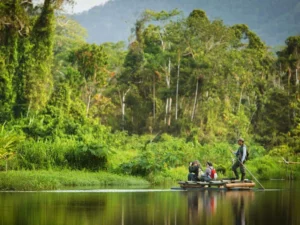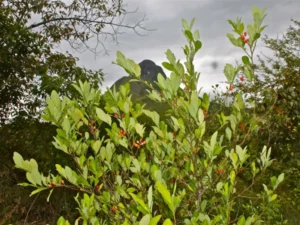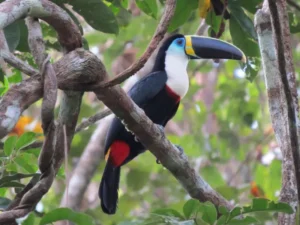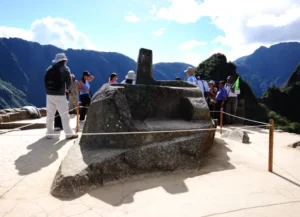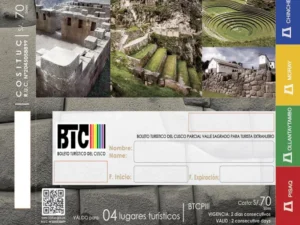The Intihuatana of Machu Picchu: The Inca Sundial
mong the millenary stones of Machu Picchu, hidden in an elevated esplanade in the upper sector of the citadel, is one of the most enigmatic and symbolic structures of the ancient Inca Empire: the Intihuatana. More than a simple carved stone, this monument is a masterpiece of astronomy, engineering and Andean spirituality. Knowing its history, function and meaning allows us to understand the deep connection that the Incas maintained with the cosmos, the sun and the natural order of the world.

Contents
What is the Intihuatana?
The term Intihuatana comes from Quechua and means “the place where the sun is tied”, composed of Inti (sun) and watayna (to tie or hold). This denomination was not used by the Incas at the time, but was coined later by scholars and archaeologists to describe a precisely carved stone that seems to be oriented towards specific solar movements.
The Intihuatana of Machu Picchu is a lithic formation of natural origin that was sculpted with great skill by the Inca builders. It is located in the northeast end of the citadel, near the Temple of the Sun and the residential sector of the priests. Its privileged location, on an elevated bedrock and with unobstructed views of the horizon, is not accidental, but the result of an intentional and symbolic design.

Astronomical and calendrical function
The Intihuatana fulfills a fundamental function as an astronomical instrument. Its design makes it possible to observe and mark the solstices and equinoxes with remarkable precision. During the June solstice (winter in the southern hemisphere), the sun is positioned in such a way that the shadow cast by the stone is almost completely aligned with its base, suggesting that the Incas used it to determine the exact time of the year when the sun reached its lowest point in the sky.
This knowledge was essential for agriculture, as it made it possible to plan plantings and harvests in harmony with natural cycles. In addition, the movements of the sun were deeply linked to the Inca worldview, in which the sun, Inti, was a central deity in the religious pantheon. The act of “binding the sun” could be interpreted as a symbolic ritual to ensure its return after the solstice, preventing it from moving away forever.
Some scholars have compared the Intihuatana to a sundial or gnomon, although its complexity goes beyond a simple time measurement. It represents an integration between science, religion and sacred geography.
Spiritual and ceremonial context
More than a technical instrument, the Intihuatana was a place of worship and connection with the divine. In the Andean cosmovision, certain places in the geography -such as mountains, rivers or rock formations- are considered wak’as (sacred beings or spiritual entities). The Intihuatana, because of its location, form and function, was probably considered a wak’a of high rank.
It is believed that specialized priests, known as willaq umu, performed ceremonies around this stone, especially during key astronomical events. Offerings of chicha (fermented beverage), coca leaves and other ritual elements may have been part of these acts, which were intended to maintain the balance between the human world, nature and the cosmos.
Its proximity to the Temple of the Sun and elite residential structures suggests that only a select group had access to this space, reinforcing its exclusive and ceremonial character.
Current status and protection
The Intihuatana of Machu Picchu is one of the few structures of its kind that has been preserved in good condition. Unlike other Intihuatanas that existed in Cusco and other regions of Tahuantinsuyo, many of which were destroyed during the Spanish conquest because they were considered pagan idols, the one at Machu Picchu remained intact thanks to the isolation of the site.
Today, the monument is protected by strict conservation rules. Visitors are allowed to observe it up close, but are not allowed to touch it or climb on it. This measure was reinforced after incidents in previous years, including a case in 2006 in which a television camera caused minor damage when it fell on the structure during filming.
The Intihuatana is part of the official circuit of visits to Machu Picchu, although its access depends on the type of ticket purchased. Some guided tours include it as a highlight, while others, for reasons of tourist flow, may temporarily omit it.
Intihuatanas in other Tahuantinsuyo regions
Although the one at Machu Picchu is the most famous, it is not the only Intihuatana that existed. Remains of similar structures have been identified at sites such as Pisac, Ollantaytambo, Tipon and Cusco, although in many cases they are eroded or partially destroyed. This evidence suggests that the use of such monuments was part of a broader system of astronomical observation and ceremonial organization in the Inca Empire.
The distribution of these structures throughout Tahuantinsuyo reflects the sophistication of Inca knowledge and their ability to adapt their practices to different geographical and climatic contexts.
Conclusion
The Intihuatana of Machu Picchu is much more than a tourist curiosity. It is a testimony of the high scientific, spiritual and cultural development achieved by the Inca civilization. Its precise design, symbolic location and astronomical function reveal a society deeply connected with natural cycles and with a vision of the universe in which time, space and the sacred were intrinsically linked.
Visiting it not only allows us to admire a millenary engineering work, but also to reflect on the human capacity to observe, understand and honor the forces of the cosmos. In that small corner of carved stone, under the Andean sky, the past continues to speak silently, waiting to be understood.


